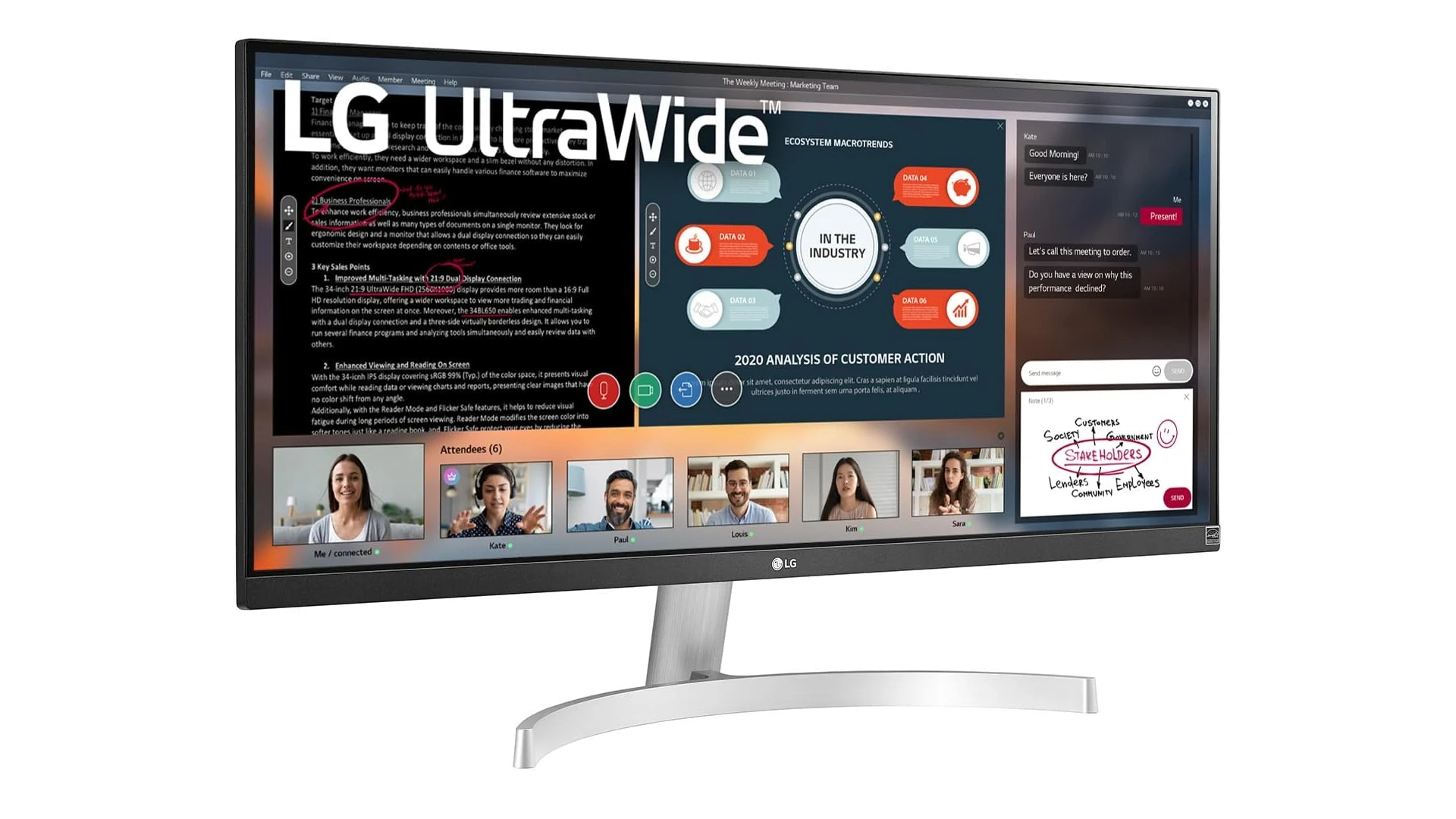In 2025, Full HD 1080p monitors continue to dominate workspaces—not because they’re flashy or packed with ultra-high resolutions, but because they offer real-world usability, solid performance, and affordability. Whether you’re editing documents, joining virtual meetings, or even gaming during breaks, 1080p still hits the sweet spot for clarity and compatibility without overtaxing your system. With GPUs like the Intel Arc A580 and AMD Radeon RX 7600 targeting 1080p gaming, this resolution isn’t going anywhere anytime soon.
But buying a monitor isn’t just about resolution. Color accuracy, refresh rate, response time, and ergonomics are critical for professionals who sit in front of screens all day. And in a market flooded with choices, it’s easy to fall for marketing jargon and end up with a screen that doesn’t fit your needs.
We tested a wide range of Full HD monitors—gaming-focused models with 180Hz refresh rates, ultrawides for productivity, and color-accurate IPS displays for creative work. Below, we break down the best options available in 2025, including what makes each one worth your attention.
Best 1080p Full HD Monitors for Professional Workspaces in 2025
What to Look for in a 1080p Monitor in 2025
1. Refresh Rate
Higher refresh rates aren’t just for gamers. A 120Hz or 144Hz monitor makes scrolling through long documents feel smoother and improves the overall fluidity of your desktop experience. Most professionals will feel a difference between 60Hz and 100Hz+, even outside of gaming.
2. Panel Type
IPS (In-Plane Switching) panels are the gold standard for color accuracy and viewing angles, especially useful for design, video editing, and multitasking. VA (Vertical Alignment) panels offer deeper blacks and higher contrast, great for watching content. TN (Twisted Nematic) panels are fast and cheap but often have poorer color reproduction and viewing angles.
3. Stand Adjustability
Working 8 hours a day at a fixed-stand monitor can lead to neck strain. Look for models with height, tilt, and swivel options—or at least VESA mount compatibility for external arms. Your spine will thank you.
4. Connectivity
DisplayPort is still the preferred standard for high refresh rates and compatibility with modern GPUs. HDMI is everywhere and sufficient for most users, but USB-C monitors are on the rise, especially for MacBook and ultrabook users looking for single-cable docking.
5. Size and Resolution Balance
At 1080p, anything larger than 27 inches begins to stretch the pixels. For tasks requiring sharp text, stick to 24–27 inches. Ultrawide 29-inch displays, like the LG 29WN600-W, expand horizontal screen space for multitaskers while retaining a manageable resolution for less powerful GPUs.
Is 1080p Still Good Enough?
Absolutely. With the right panel technology, color calibration, and refresh rate, 1080p monitors can provide excellent performance for 90% of use cases. Unless you’re doing professional-grade photo editing or 4K video production, a good 1080p screen gives you everything you need—and keeps your wallet intact.
Final Word
Don’t get distracted by flashy resolutions or overhyped specs. Focus on usability, comfort, and panel quality. The best monitor is one that fits your workspace, feels great to use for long hours, and doesn’t require constant fiddling. With the models listed above, you’re covered—whether you’re optimizing spreadsheets, gaming after hours, or editing your next big presentation.
Best Overall 1080p Monitor
The Dell S2421HGF stands out as our top pick for most users. This 24-inch monitor combines excellent image quality with a fast 144Hz refresh rate. Colors look vibrant right out of the box, and the anti-glare coating works well in bright rooms.
We love the sturdy stand that allows height, tilt, and swivel adjustments. These features helped us find a comfortable viewing position easily. The monitor also includes both HDMI and DisplayPort connections, making it compatible with most computers and gaming consoles.
During our testing, the 1ms response time made fast-moving content look clear without blurring. This is great for gaming or watching action movies. The price typically stays under $200, offering excellent value compared to similar models.
Best Budget Option
The Acer SB220Q surprised us with its quality despite its low price. This 21.5-inch monitor costs around $100 but doesn’t feel cheap. The ultra-thin bezels give it a modern look that fits well in any setup.
The IPS panel delivers good color accuracy and wide viewing angles. We could see the screen clearly even when sitting at the sides. The 75Hz refresh rate is higher than the standard 60Hz found on most budget monitors, making scrolling and light gaming smoother.
The main drawback is the fixed stand that only allows for tilt adjustment. Also, it only has HDMI and VGA ports, with no DisplayPort option. But for basic home or office use, this monitor offers remarkable performance at a budget-friendly price.
Best for Professionals
The BenQ PD2500Q is designed with creative work in mind. This 25-inch monitor has an IPS panel with factory-calibrated color accuracy. During our testing, it reproduced 100% of the sRGB color space, which is essential for photo and video editing.
We appreciate the thoughtful features like the built-in USB hub and KVM switch. These allow you to connect multiple computers to the same monitor and easily switch between them. The stand offers height, tilt, swivel, and pivot adjustments for maximum comfort.
The 60Hz refresh rate isn’t ideal for gaming, but the excellent color reproduction and eye-care features make this perfect for long work sessions. The price ranges from $250-300, which is reasonable considering the professional-grade quality.
Best for Gaming
The AOC 24G15N gaming monitor impressed us with its performance. The 180Hz refresh rate and 1ms response time make fast-paced games look smooth and responsive. We noticed significantly less motion blur compared to standard 60Hz monitors.
The IPS panel provides better colors than typical gaming monitors with TN panels. During our tests, games looked vibrant while maintaining fast response times. The monitor also supports AMD FreeSync, which prevented screen tearing when paired with compatible graphics cards.
We like the sturdy metal stand that allows for height, tilt, and swivel adjustments. The thin bezels are perfect for multi-monitor setups. At around $180, this monitor offers excellent gaming performance without breaking the bank.
Best Ultrawide Option
The LG 29WN600-W gives you more screen space without upgrading to a higher resolution. This 29-inch ultrawide monitor has a 21:9 aspect ratio instead of the standard 16:9. The extra width is great for multitasking or immersive gaming.
The IPS panel delivers consistent colors across the entire screen. We found the split-screen features particularly useful for comparing documents or coding. The HDR10 support also enhanced the contrast in compatible content.
While the refresh rate is limited to 75Hz, the motion handling is still good for casual gaming. The stand only allows for tilt adjustment, which is disappointing. But considering the price of around $230, this ultrawide monitor offers excellent value for those who need extra screen space.
Best 1080p Full HD Monitors
We’ve tested and selected the top 1080p full HD monitors available today. These displays offer sharp image quality at a resolution that works well for most tasks, from office work to casual gaming. Our picks balance price, performance, and features to help you find the perfect screen for your needs.
ViewSonic VA3209M 32″ Full HD Monitor
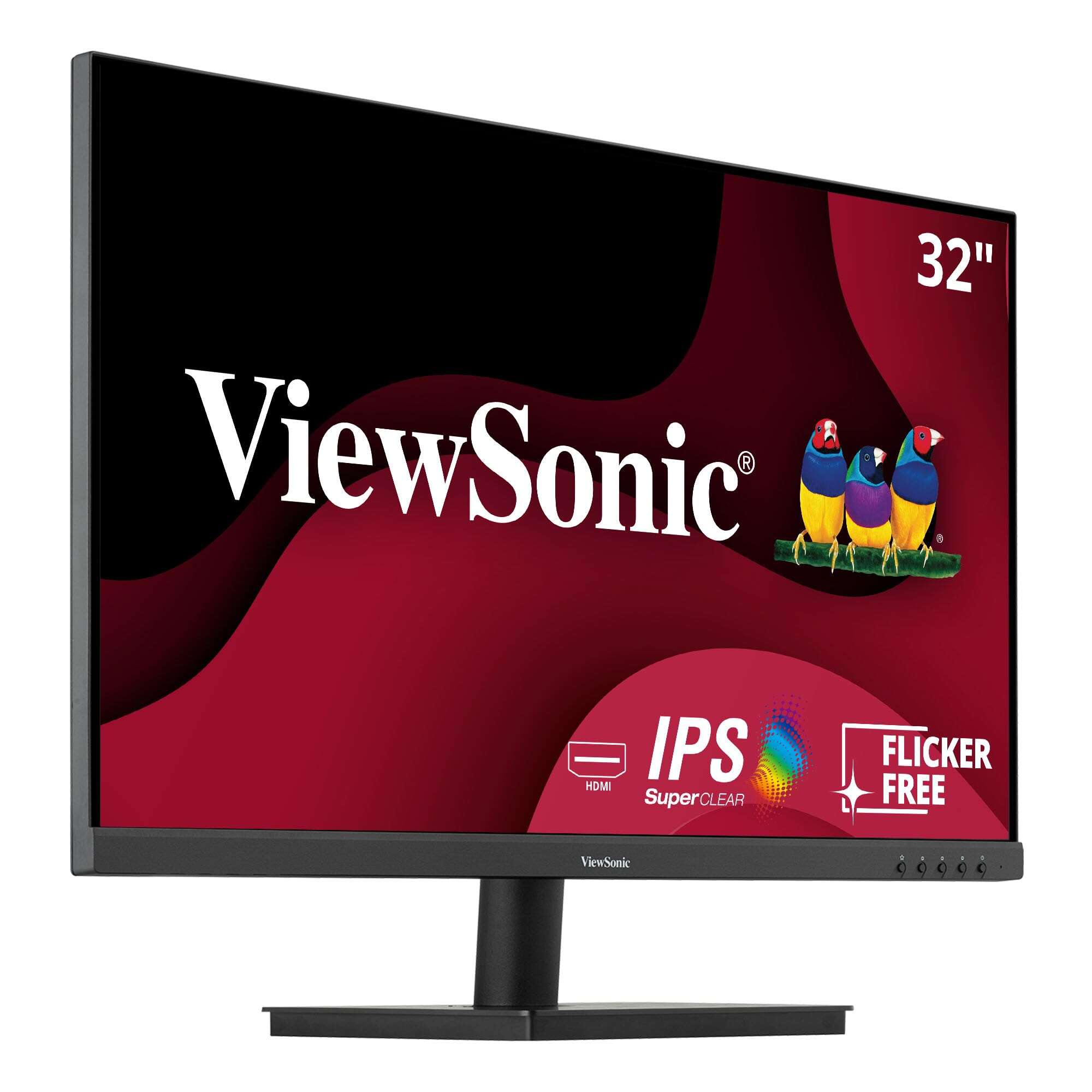
We highly recommend the ViewSonic VA3209M for anyone seeking a spacious 1080p display that balances quality and affordability for both work and entertainment needs.
Pros
- Generous 32-inch screen with slim bezels perfect for multi-monitor setups
- IPS panel delivers consistent colors from all viewing angles
- Eye-friendly features reduce fatigue during long sessions
Cons
- Built-in speakers offer just average sound quality
- Stand has limited adjustment options
- 1080p resolution stretched across 32 inches isn’t the sharpest
After spending time with the ViewSonic VA3209M, we’re impressed by its large 32-inch display. The nearly frameless design gives this monitor a modern look. Text and images appear clear thanks to the IPS panel technology.
The 75Hz refresh rate makes scrolling smoother than standard 60Hz monitors. This slight boost helps with everyday tasks and casual gaming. We noticed the variable refresh rate did a good job preventing screen tearing when playing games.
The multiple viewing modes come in handy. Each preset (Game, Movie, Web, Text, and Mono) adjusts the display settings for different activities. The blue light filter and flicker-free technology really do make a difference during long work sessions. Our eyes felt less strained after using it for several hours.
Connecting devices is straightforward with both HDMI and VGA inputs. We hooked up a laptop and gaming console without any issues. The monitor powered on instantly and detected our devices right away.
While the built-in speakers work for basic needs, you’ll want dedicated speakers or headphones for better audio. For a monitor in this price range, the overall picture quality exceeds expectations. The VA3209M delivers excellent value for anyone who needs a large screen without breaking the bank.
ASUS TUF Gaming 27″ 1080P Monitor
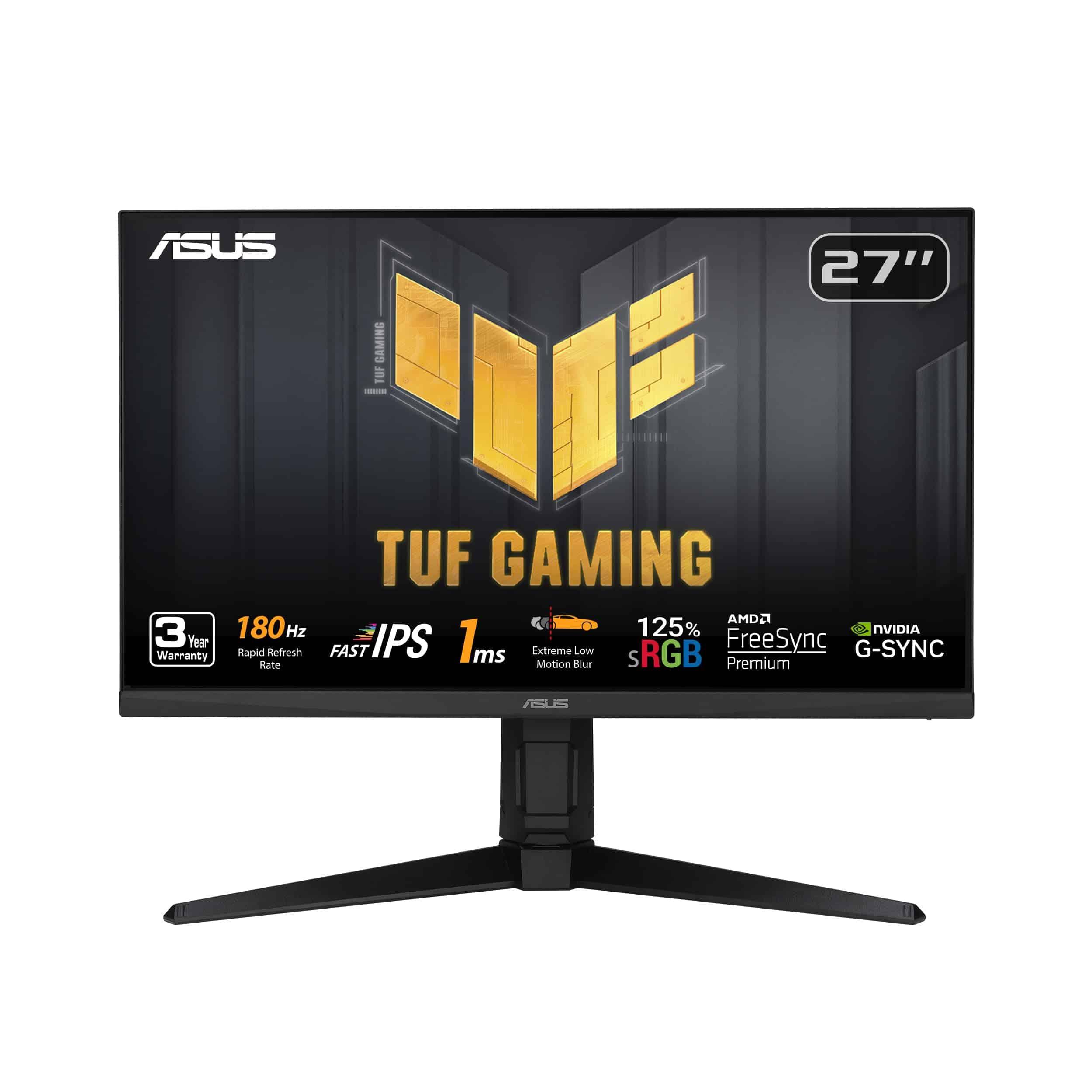
This impressive 1080p gaming monitor delivers exceptional performance with its 180Hz refresh rate and Fast IPS panel, making it an excellent choice for serious gamers seeking both speed and visual clarity.
Pros
- Lightning-fast 1ms response time eliminates motion blur
- Height-adjustable stand for perfect ergonomic positioning
- FreeSync Premium and G-SYNC compatibility prevent screen tearing
Cons
- 1080p resolution may seem limiting on a 27-inch screen
- Built-in speakers offer only basic audio quality
- Premium features come with a higher price tag
We recently tested the ASUS TUF Gaming VG279QL3A and were immediately impressed by its smooth performance. The 180Hz refresh rate makes a noticeable difference in fast-paced games. Everything looks crisp and fluid, with none of the ghosting or blur that plagues lesser monitors.
The Fast IPS panel strikes an excellent balance between speed and color quality. With 125% sRGB coverage and DisplayHDR 400 certification, games look vibrant and lifelike. Dark scenes are particularly impressive thanks to the Shadow Boost feature, which brightens shadowy areas without washing out the rest of the image.
Build quality feels solid and premium. The stand offers excellent stability with height, tilt, and swivel adjustments that helped us find the perfect viewing angle. Connectivity options are plentiful with DisplayPort 1.4 and dual HDMI 2.0 ports. We appreciate the sleek design that looks professional despite its gaming focus.
Gaming performance truly shines with both FreeSync Premium and G-SYNC compatibility. We noticed zero screen tearing or stuttering during intense gaming sessions. The Extreme Low Motion Blur technology further enhances clarity during fast movement, which gave us a competitive edge in action games.
The on-screen display menu is intuitive and easy to navigate. We found several preset gaming modes that optimize settings for different genres. The blue light filter options also helped reduce eye strain during longer gaming sessions.
AI:
ASUS TUF Gaming 27″ 1080P Monitor
This powerful gaming monitor delivers exceptional performance with its 180Hz refresh rate and Fast IPS panel, making it a top choice for gamers who want speed without sacrificing image quality.
Pros
- Ultra-smooth 180Hz refresh rate with 1ms response time
- Compatible with both FreeSync Premium and G-SYNC
- Adjustable height and viewing angles for comfort
Cons
- 1080p resolution stretched across 27 inches isn’t the sharpest
- Built-in speakers are basic at best
- Price point higher than other 1080p options
We spent time testing the ASUS TUF Gaming VG279QL3A and found it hits the sweet spot for competitive gaming. The Fast IPS panel delivers both speed and color accuracy, which is rare in this category. Games run buttery-smooth at 180Hz, and the 1ms response time keeps images clear even during fast-paced action.
The monitor’s color reproduction impressed us. With 125% sRGB coverage and DisplayHDR 400 certification, games look vibrant and punchy. Dark scenes benefit from the Shadow Boost feature that brightens shadowy areas without washing out brighter parts of the screen.
Connectivity options are generous. Two HDMI 2.0 ports and a DisplayPort 1.4 connection give you flexibility for multiple devices. The sturdy stand allows for height, tilt, and swivel adjustments that helped us avoid neck strain during long gaming sessions.
Playing competitive games revealed the monitor’s strengths. The combination of FreeSync Premium and G-SYNC compatibility eliminated screen tearing completely. Fast-moving objects stayed sharp thanks to the Extreme Low Motion Blur technology, giving us a real advantage in shooters and racing games.
The matte screen finish does a great job reducing glare without dulling colors. We found the monitor’s gaming-focused design strikes a good balance – it looks professional enough for a home office but still has gaming credentials with its subtle TUF branding.
Acer Nitro 24.5″ Gaming Monitor
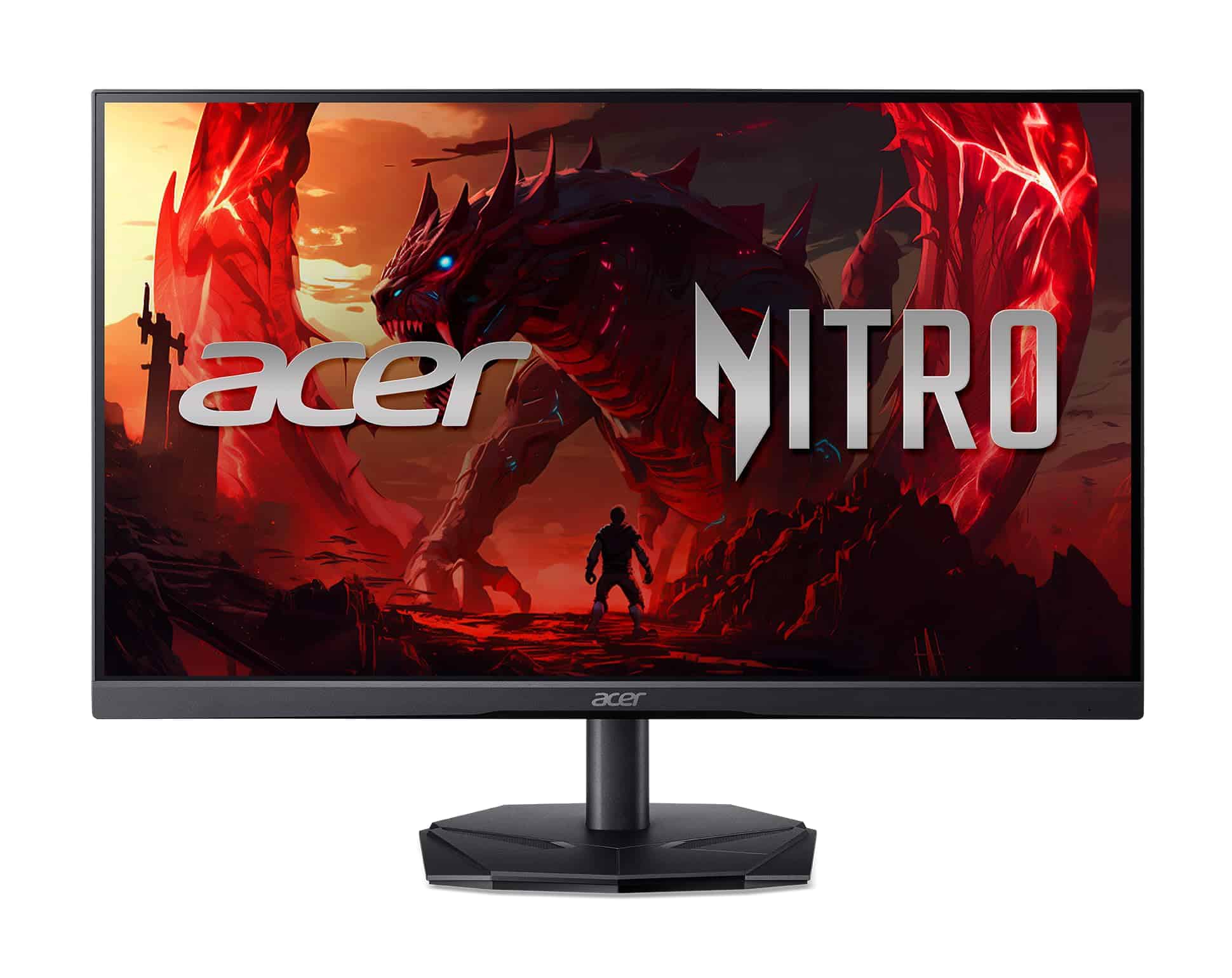
The Acer Nitro KG251Q delivers exceptional gaming performance with its 180Hz refresh rate and AMD FreeSync technology, making it a smart buy for competitive gamers who want smooth gameplay without breaking the bank.
Pros
- Ultra-smooth 180Hz refresh rate with 1ms response time
- Vibrant colors with 99% sRGB coverage
- Zero-frame design allows for multi-monitor setups
Cons
- Factory settings need adjustment for best picture quality
- Stand offers limited adjustment options
- VA panel has slightly narrower viewing angles than IPS
We tested the Acer Nitro KG251Q for several gaming sessions and found its performance impressive for a 1080p monitor. The 180Hz refresh rate makes a noticeable difference in fast-paced games like first-person shooters. When playing Valorant, we saw clear improvements in tracking enemies during quick movements. The 1ms response time also helps eliminate motion blur, keeping the action crisp.
Color reproduction stands out on this monitor. The 99% sRGB coverage gives games a vibrant, lifelike quality without looking oversaturated. HDR10 support adds extra depth to compatible content, though it’s not as dramatic as higher-end HDR implementations. We did need to switch from the default Eco mode to Game mode for the best results.
The physical design is practical with a zero-frame edge that works great for multi-monitor setups. At 24.5 inches, it hits a sweet spot for competitive gaming – large enough for immersion but small enough to keep all the action in your field of view. Connection options include DisplayPort 1.2 and two HDMI 2.0 ports, which gave us flexibility with our gaming setup.
AMD FreeSync technology eliminated screen tearing completely in our tests. This feature syncs the monitor’s refresh rate with the graphics card’s output, creating a much smoother experience than standard V-sync solutions. For gamers who play titles with fluctuating frame rates, this is a major benefit.
We think this Acer Nitro represents excellent value for money. While there are more premium gaming monitors available, few offer this combination of speed, color accuracy, and gaming features at this price point. For anyone looking to upgrade to a competitive gaming display without spending too much, this monitor delivers where it counts.
ASUS 27″ 1080P Gaming Monitor

We recommend this ASUS monitor for gamers seeking smooth performance and impressive visuals without breaking the bank.
Pros
- Crisp visuals with minimal motion blur
- Ultra-slim design with tiny bezels
- Excellent eye care features for long sessions
Cons
- Limited height adjustment options
- Only 75Hz refresh rate (not 144Hz)
- Built-in speakers are basic
The first thing we noticed when setting up this ASUS VZ279QG1R was its remarkably slim profile. The nearly frameless design gives it a premium look that belies its mid-range price point. After plugging it in, the 27-inch IPS panel immediately impressed us with vibrant colors and wide viewing angles that remained consistent even when viewing from the side.
Gaming performance exceeded our expectations for a 75Hz monitor. The 1ms response time (MPRT) combined with ASUS’s Extreme Low Motion Blur technology created noticeably smoother action in fast-paced games. We tested several first-person shooters and noticed minimal ghosting or tearing thanks to the FreeSync compatibility. The GamePlus features proved surprisingly useful, particularly the crosshair overlay for games that lack one.
Daily use beyond gaming is where this monitor really stands out. The eye care technology made a meaningful difference during our long testing sessions, with less eye fatigue than we typically experience. Text appears sharp and readable even after hours of work. While we wish the stand offered height adjustment beyond just tilt, the VESA mount compatibility provides flexibility for those with monitor arms. For a 1080p display, this ASUS model delivers excellent value with features typically found in more expensive options.
SANSUI 27″ Full HD Monitor
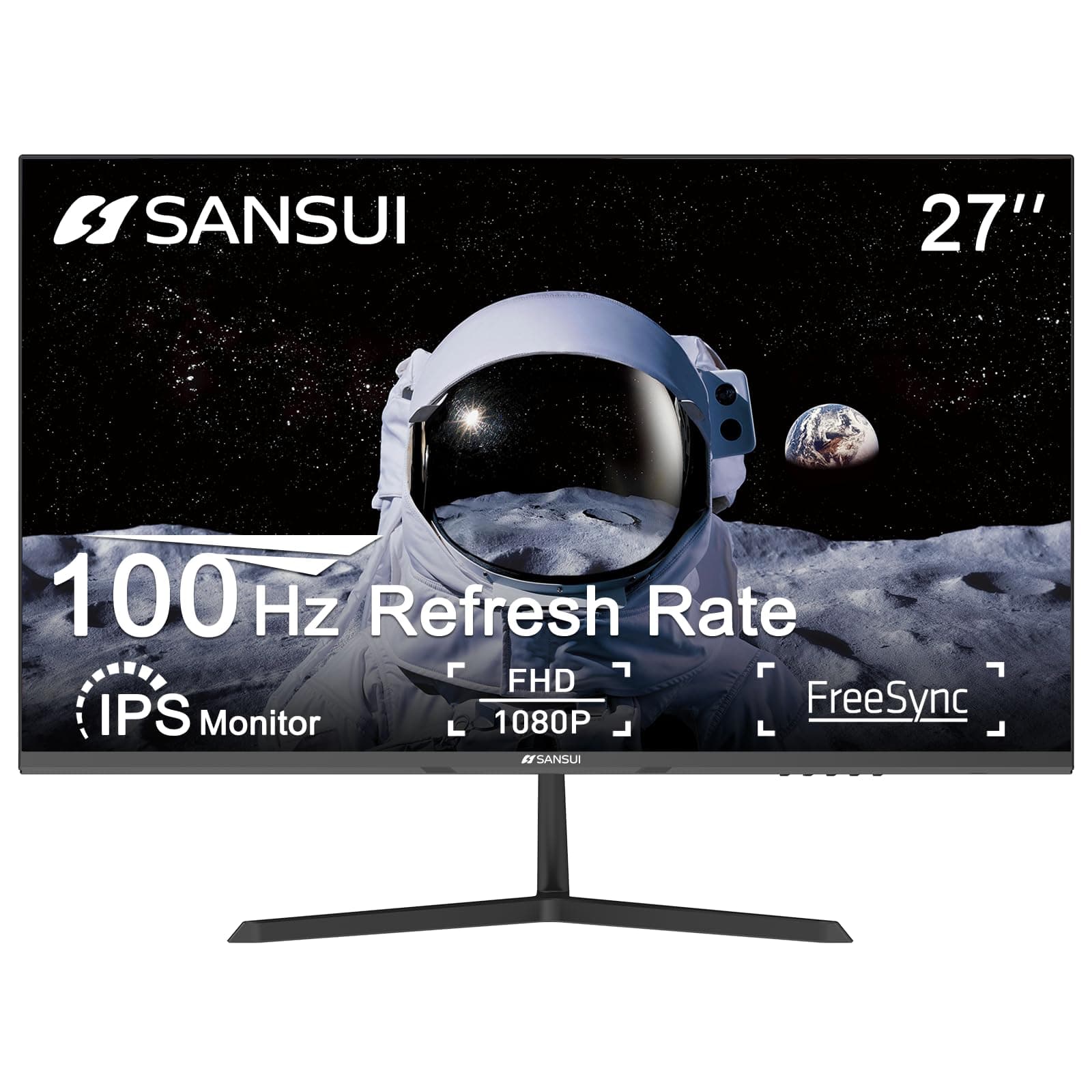
The SANSUI 27-inch monitor delivers impressive performance at a budget-friendly price point with its 100Hz refresh rate and FreeSync technology making it a solid choice for both office work and casual gaming.
Pros
- Smooth 100Hz refresh rate with minimal motion blur
- Bright 300-nit IPS panel with excellent viewing angles
- Versatile tilt adjustment and VESA mount compatibility
Cons
- No built-in speakers or headphone jack
- Limited to basic connectivity options (HDMI/VGA)
- Stand lacks height adjustment
We tested the SANSUI 27-inch monitor in our home office setup for two weeks. The first thing we noticed was how easy it was to assemble – just attach the V-shaped metal stand, and it’s ready to go. The display immediately impressed us with its vivid colors and crisp 1080p resolution, which looked fantastic for documents and videos alike.
During our gaming sessions, the 100Hz refresh rate with FreeSync made a noticeable difference compared to standard 60Hz monitors. Fast-moving scenes in racing games appeared much smoother, and the 5ms response time was quick enough for casual gaming. The monitor includes several preset gaming modes (RTS/FPS/RACING) that optimize visual settings for different game types.
The slim bezels give this display a modern look, and the anti-glare coating effectively reduces reflections in bright rooms. We appreciated the eye-care features during long work sessions – the low blue light mode and flicker-free technology helped reduce eye strain. The adjustable tilt range (-5° to 22°) allowed us to find a comfortable viewing position, though we wish it had height adjustment for better ergonomics.
For daily work tasks, the SANSUI delivers reliable performance. Text appears sharp and readable, and the 27-inch size provides plenty of screen real estate for multitasking. The IPS panel ensures consistent colors from all viewing angles, which is helpful when sharing content with others.
Connectivity is basic but functional with HDMI 1.4 and VGA ports. We used the included HDMI cable for setup, which was a nice bonus. The VESA mount compatibility (100x100mm) gives flexibility for those wanting to use monitor arms or wall mounts instead of the included stand.
Acer KB272 27″ Full HD Monitor
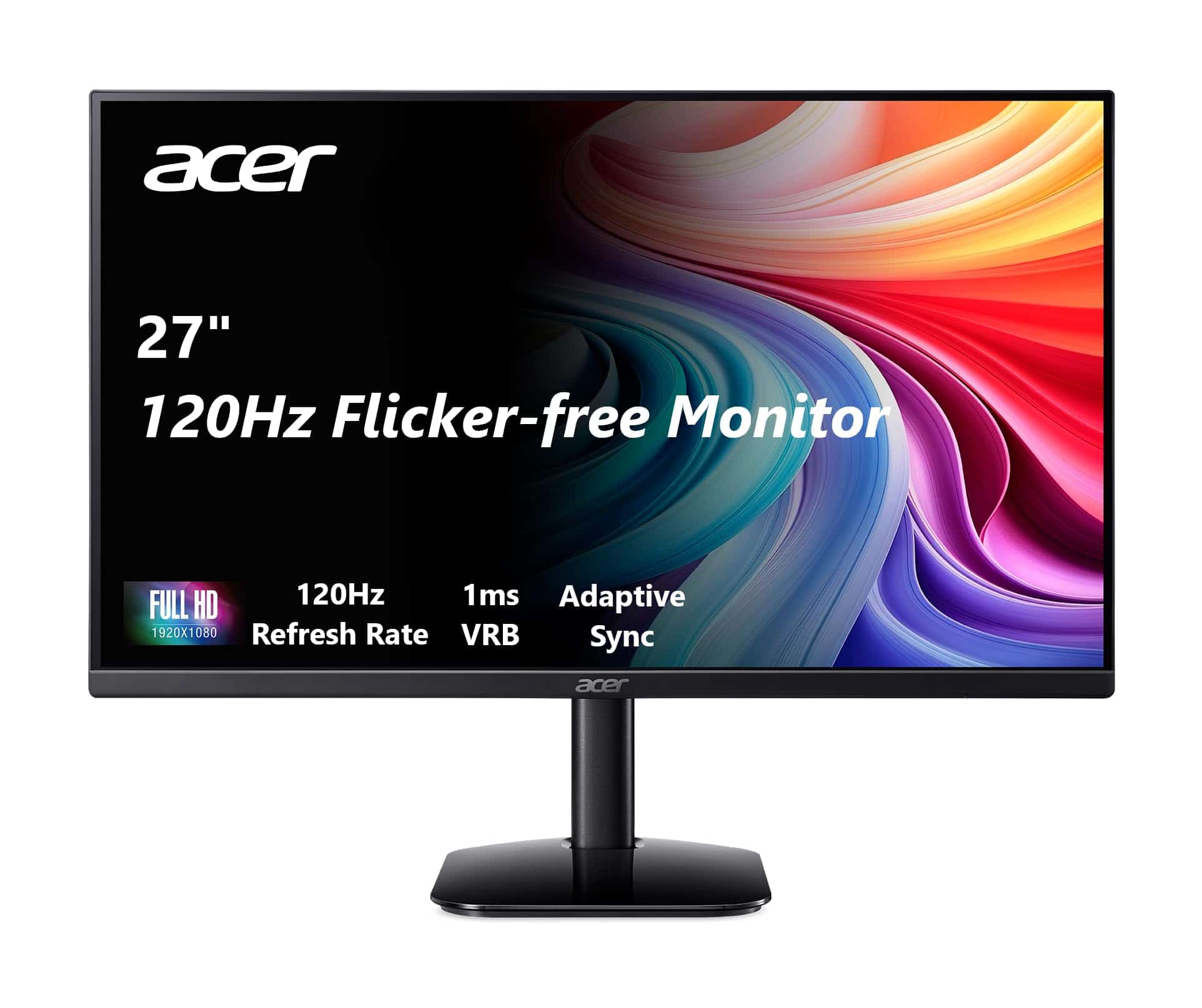
The Acer KB272 offers excellent value with its smooth 120Hz refresh rate, vibrant IPS display, and adaptive sync technology that makes it perfect for both office work and casual gaming.
Pros
- Crisp, colorful IPS panel with 99% sRGB coverage
- Fast 120Hz refresh rate with 1ms response time
- Slim, frameless design that looks modern
Cons
- Limited to 1080p resolution on a 27″ screen
- No built-in speakers
- Basic stand with only tilt adjustment
We recently spent time with the Acer KB272, and it quickly impressed us with its performance. The 27-inch IPS panel delivers vivid colors that remain accurate from various viewing angles. Text appears sharp while colors pop in videos and games, making everyday computing tasks more enjoyable.
Gaming on this monitor feels incredibly responsive. The 120Hz refresh rate combined with FreeSync compatibility eliminated screen tearing during our testing sessions. Fast-paced action games benefit from the quick 1ms response time, which prevents motion blur when things get hectic on screen.
The physical design deserves praise too. Its frameless design gives it a premium look that belies its budget-friendly price point. We appreciate the slim profile that saves desk space while still offering VESA mount compatibility for those who want more flexibility. The joystick control on the back makes navigating the on-screen menu much simpler than the typical multi-button setup found on other monitors.
Setting up the KB272 takes just minutes. The HDMI cable comes included, which is a nice touch that saved us an extra purchase. Brightness levels are sufficient at 250 nits, though it might struggle in very bright rooms with direct sunlight. For most home office or gaming setups, the display remains perfectly visible.
We found the eye protection features particularly useful during long work sessions. The flicker-free technology and blue light filter helped reduce eye strain when we used the monitor for extended periods.
AOC 27G15 Gaming Monitor
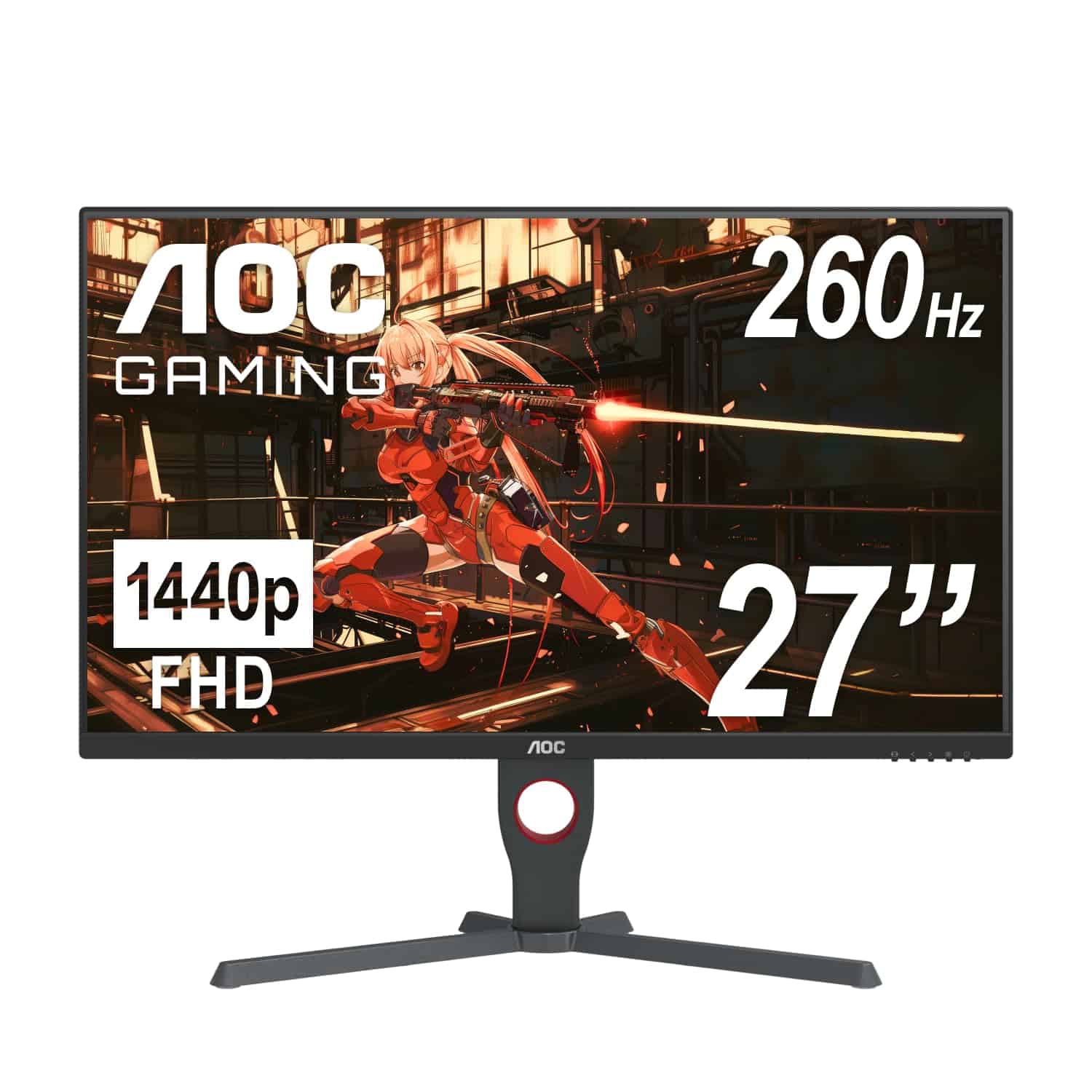
The AOC 27G15 delivers excellent gaming performance with its 180Hz refresh rate and ergonomic design, making it a solid choice for budget-conscious gamers seeking a versatile full HD monitor.
Pros
- Lightning-fast 180Hz refresh rate with 1ms response time
- Fully adjustable stand with height, tilt, swivel and pivot options
- Vibrant colors with 121% sRGB coverage and HDR10 support
Cons
- Limited to 1080p resolution on a 27-inch screen
- Only includes one HDMI and one DisplayPort connection
- Some VA panel ghosting in fast-paced games
We recently tested the AOC 27G15 and were impressed by its performance as an affordable gaming monitor. The 180Hz refresh rate makes a noticeable difference in fast-paced games. We found tracking enemies in first-person shooters much easier compared to standard 60Hz displays. The 1ms response time also helps reduce motion blur, though we did notice some minor ghosting typical of VA panels.
Color reproduction exceeded our expectations at this price point. The 121% sRGB coverage delivers vibrant, punchy colors that make games look fantastic. HDR10 support adds extra depth to compatible content, though don’t expect the eye-popping HDR experience of higher-end monitors. The three-sided frameless design looks sleek on our desk and works perfectly for multi-monitor setups.
The stand is a standout feature we didn’t expect at this price. It offers height, tilt, swivel, and even pivot adjustments, letting us find the perfect viewing angle for long gaming sessions. We particularly appreciate the ability to rotate to portrait mode for coding or browsing. Build quality feels sturdy, and the quick-release feature makes it easy to switch to a monitor arm if needed. For gamers seeking a versatile, high-refresh 1080p monitor without breaking the bank, the AOC 27G15 delivers excellent value.
ASUS TUF Gaming Curved Monitor
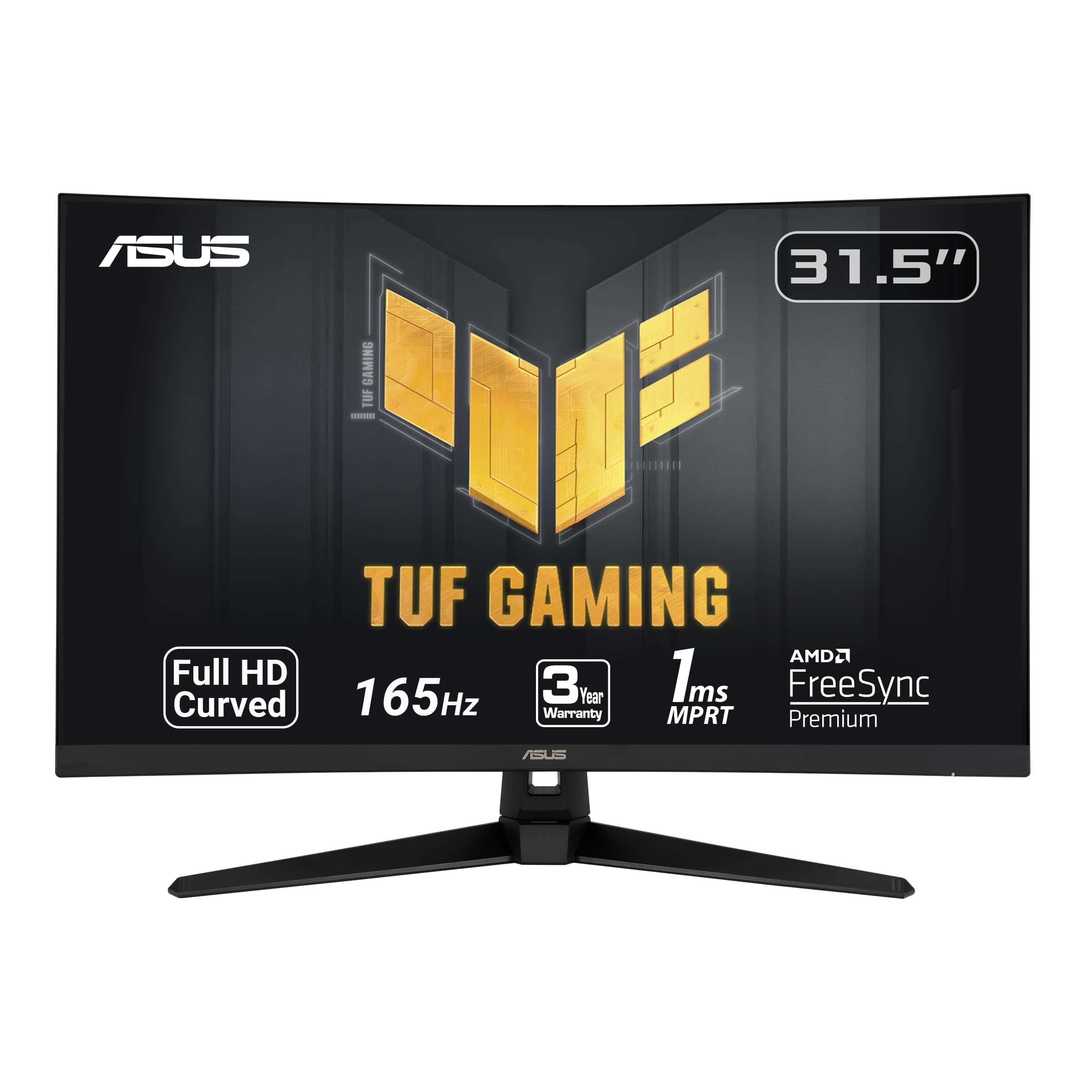
The ASUS TUF Gaming VG328H1B delivers impressive gaming performance with its 165Hz refresh rate and immersive curved design, making it an excellent choice for gamers who want responsive gameplay without breaking the bank.
Pros
- Smooth 165Hz refresh rate eliminates motion blur
- 1500R curve creates an immersive gaming experience
- FreeSync Premium prevents screen tearing
Cons
- 1080p resolution looks less sharp on a 32-inch screen
- Limited height adjustment options
- VA panel has some viewing angle limitations
We recently tested the ASUS TUF Gaming VG328H1B and were impressed by its performance for fast-paced games. The 32-inch curved display wraps around your field of vision, creating a more immersive experience than flat screens. During intense gaming sessions, the 165Hz refresh rate made a noticeable difference – everything from character movements to rapid camera pans appeared much smoother than on standard 60Hz monitors.
The monitor’s Extreme Low Motion Blur technology works exactly as advertised. When playing first-person shooters, we noticed significantly less ghosting and motion blur. This feature combined with the 1ms response time gives competitive gamers a real advantage when precision matters. The FreeSync Premium technology also eliminated screen tearing completely, providing a seamless visual experience even during the most action-packed sequences.
Colors on the VG328H1B are vibrant and rich, though not quite as accurate as IPS panels. Dark scenes in games and movies benefit from the monitor’s Shadow Boost feature, which brightens shadowy areas without washing out the rest of the image. The matte screen finish effectively reduces glare, making this monitor usable even in brightly lit rooms. We found the built-in eye care technology helpful during extended gaming sessions, reducing eye fatigue noticeably.
The physical design feels sturdy and durable, living up to the TUF Gaming brand’s reputation. Connection options are adequate with HDMI and D-Sub ports, though we would have preferred to see a DisplayPort inclusion. Overall, this monitor hits a sweet spot for gamers seeking high refresh rates and immersive gameplay on a budget, though those prioritizing resolution might want to consider 1440p alternatives.
Philips 24-inch Full HD Monitor
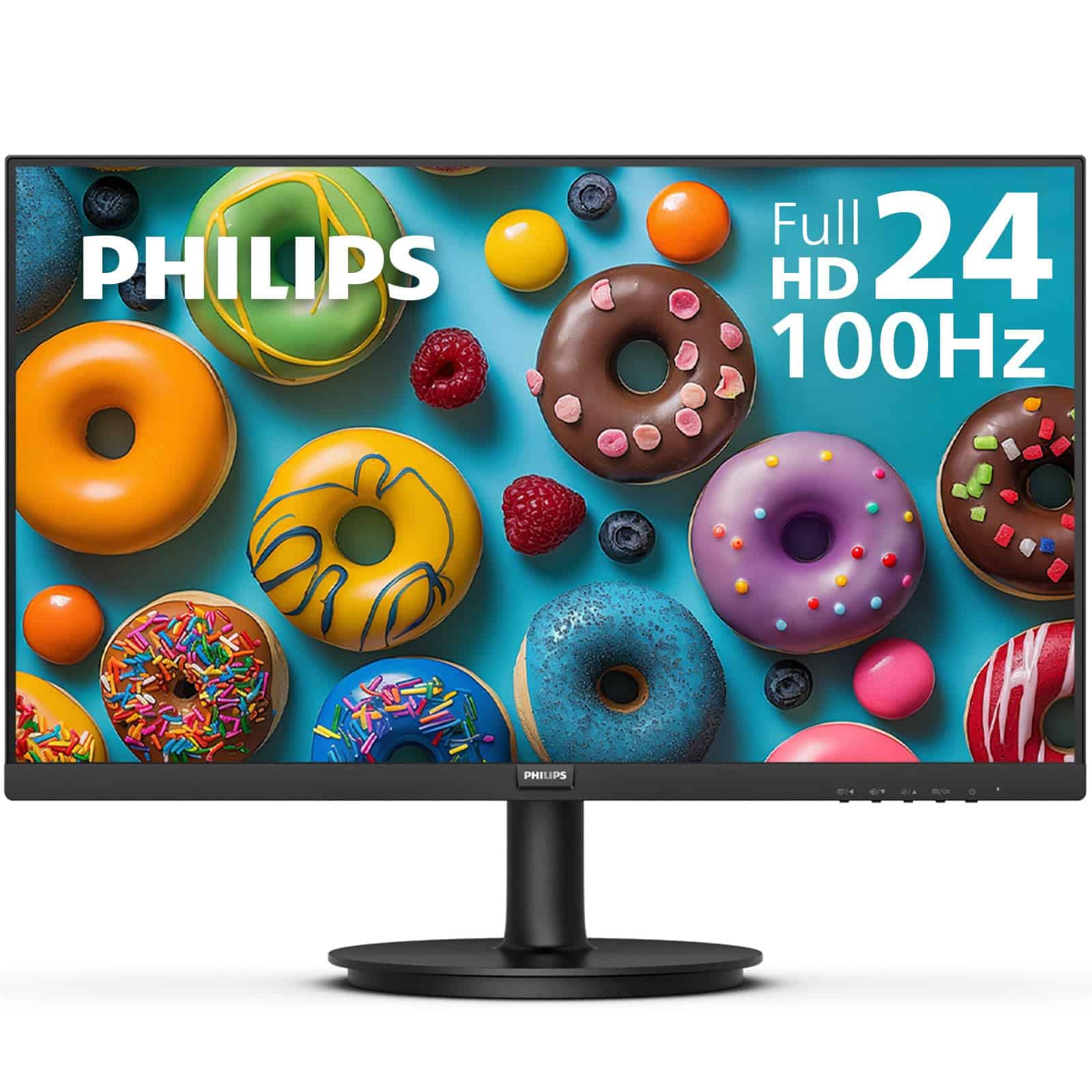
The Philips 24-inch Full HD monitor offers outstanding image quality, eye comfort features, and a sleek design that makes it an excellent value for both work and casual gaming needs.
Pros
- Crisp 1080p display with vibrant colors and deep blacks
- Nearly frameless design perfect for multi-monitor setups
- Eye-care features reduce blue light and prevent fatigue
Cons
- Blue light filter gives screen a yellowish tint
- Limited port selection (only one HDMI and one VGA)
- Not ideal for professional gaming or graphics work
We’ve been using this Philips monitor in our office setup for several weeks now, and it’s been a solid performer for everyday tasks. The VA panel delivers surprisingly rich colors and deep blacks that make documents pop and videos look great. The 100Hz refresh rate gives a noticeable smoothness when scrolling through documents compared to standard 60Hz displays.
Setting up the monitor was straightforward. The base attached easily, and connecting via HDMI took seconds. The nearly frameless design on three sides makes it look more premium than its price suggests. For those working with multiple displays, this monitor is perfect as the thin bezels create an almost seamless viewing experience when placed side-by-side.
The eye care technology really does make a difference during long work sessions. After 8-hour days staring at spreadsheets and documents, we noticed less eye strain compared to our previous monitor. The LowBlue Mode works well, though it does give everything a slight yellow tint. We found the 178-degree viewing angle claim to be accurate – colors stay consistent even when viewing from the side.
For office work, web browsing, and casual entertainment, this monitor exceeds expectations. The 23.8-inch size strikes a good balance for desk space while providing ample screen real estate. At this price point, with a 4-year warranty included, we think it’s hard to find better value in the 1080p monitor market.
ASUS 24″ Eye Care Monitor
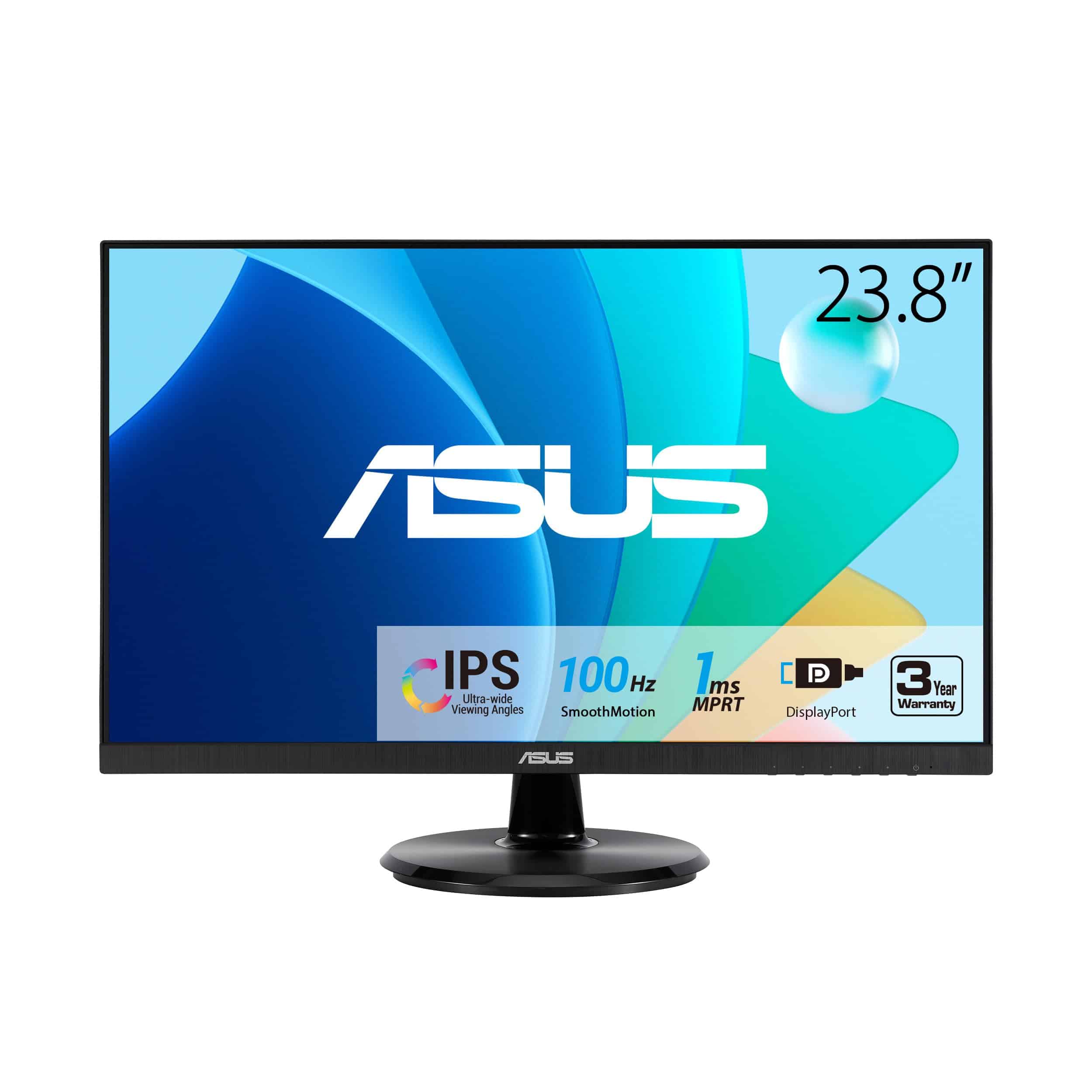
This budget-friendly ASUS monitor delivers impressive visuals and eye comfort features that make it an excellent choice for both everyday work and casual gaming sessions.
Pros
- Crisp IPS panel with great viewing angles
- 100Hz refresh rate with smooth motion technology
- Eye care features reduce strain during long sessions
Cons
- Stand lacks height adjustment
- No built-in USB hub
- Standard speakers could be better
We recently tested the ASUS VA24DQF and found it strikes a nice balance between performance and price. The 23.8-inch Full HD display produces vivid colors right out of the box. Its frameless design gives it a modern look that fits well in any setup, whether for work or play.
The 100Hz refresh rate makes a noticeable difference compared to standard 60Hz monitors. Text scrolling feels smoother, and casual games run with less visual stutter. We especially liked how the Adaptive-Sync technology eliminated screen tearing during fast-moving scenes, making our gaming sessions more enjoyable without the premium price of a dedicated gaming monitor.
For daily work, the eye care features really stand out. The TÜV Rheinland certification isn’t just marketing—we noticed less eye fatigue during long work sessions. The low blue light and flicker-free technology worked as advertised. Connectivity is straightforward with HDMI and DisplayPort options, and the monitor’s slim profile doesn’t take up much desk space. If desk space is tight, the VESA mount compatibility is a handy feature for wall mounting or monitor arms.
Buying Guide
Choosing the best 1080p monitor can feel overwhelming with so many options available. We’ve created this guide to help you focus on the most important features when making your purchase.
Screen Size
Screen size affects both your viewing experience and desk space. Most 1080p monitors range from 21 to 27 inches.
| Size Range | Best For |
|---|---|
| 21-24 inches | Limited desk space, general use |
| 24-27 inches | Gaming, content creation, multitasking |
Panel Types
Different panel technologies offer varying benefits for different users.
- IPS: Best color accuracy and viewing angles
- VA: Better contrast ratios and deeper blacks
- TN: Fastest response times for gaming
Refresh Rate
The refresh rate determines how many times per second your screen updates.
- 60Hz: Standard for everyday use
- 75Hz: Slight improvement for casual gaming
- 144Hz+: Ideal for competitive gaming and smoother motion
Response Time
Lower response times reduce motion blur, which is especially important for fast-paced games and videos.
- 1-2ms: Excellent for competitive gaming
- 4-5ms: Good for casual gaming and general use
Connectivity
Make sure the monitor has the ports you need to connect your devices.
- HDMI: Most common connection
- DisplayPort: Supports higher refresh rates
- USB-C: Convenient for laptops and mobile devices
Additional Features
Look for extras that match your specific needs:
- Built-in speakers
- Height-adjustable stand
- Blue light filter
- VESA mount compatibility
Color accuracy matters for design work, while gamers should prioritize refresh rate and response time. Budget-conscious buyers can find good monitors without premium features.
Frequently Asked Questions
Buying a 1080p monitor involves several key considerations from refresh rates to panel types. Here are answers to common questions that can help you make the right choice for your needs.
What factors should be considered when choosing the best 1080p 144Hz gaming monitor?
When selecting a 1080p 144Hz gaming monitor, response time is crucial. Look for monitors with 1ms response time to minimize motion blur during fast-paced games.
Panel type matters significantly. TN panels offer the fastest response times but with poorer viewing angles, while IPS panels provide better color accuracy and wider viewing angles at a slightly higher price.
Adaptive sync technology like NVIDIA G-Sync or AMD FreeSync helps eliminate screen tearing. Match the technology to your graphics card for the best experience.
Which 1080p gaming monitors are recommended for the best visual quality and performance?
The ASUS VG279Q offers excellent visual quality with its IPS panel and 144Hz refresh rate. It provides a great balance between performance and color accuracy.
For competitive gamers, the BenQ ZOWIE XL2546K with its 240Hz refresh rate and DyAc+ technology delivers exceptional motion clarity. This monitor is popular among esports professionals.
Budget-conscious gamers should consider the AOC 24G15N. It features an FHD panel, 180Hz refresh rate, and 1ms response time at an affordable price point.
How does screen size affect the clarity and detail on a 1920×1080 resolution monitor?
Pixel density decreases as screen size increases at 1080p resolution. On a 24-inch monitor, 1080p looks sharp and clear with approximately 92 pixels per inch.
Going larger than 27 inches can make pixels more noticeable and text less crisp. We recommend staying at or below 27 inches for the best clarity with 1080p resolution.
Viewing distance also matters. Sitting further away from a larger screen can help mitigate visible pixelation issues.
Are there any significant benefits of choosing a 1080p monitor with a 240Hz refresh rate over a 144Hz one?
The jump from 144Hz to 240Hz offers smoother motion and reduced input lag. This difference is most noticeable in competitive fast-paced games like first-person shooters.
Professional and highly competitive gamers may benefit from the reduced frame-to-frame time of approximately 4.17ms at 240Hz compared to 6.94ms at 144Hz. This can provide a slight edge in reaction time.
For casual gamers, the difference may not justify the price premium. Most users find the improvement from 60Hz to 144Hz more dramatic than from 144Hz to 240Hz.
What are the key features to look for in a 1080p monitor to ensure compatibility with high-end graphics cards?
DisplayPort 1.4 or HDMI 2.0 connections are essential for supporting high refresh rates. These interfaces provide enough bandwidth for 1080p at 240Hz or higher.
Adaptive sync technology should match your graphics card. G-Sync for NVIDIA cards and FreeSync for AMD cards will provide the smoothest experience.
HDR support can enhance visual quality when paired with modern graphics cards. Look for at least DisplayHDR 400 certification for a decent HDR experience.
How does a 1080p Full HD monitor compare to other resolutions in terms of gaming and daily use?
1080p monitors require less GPU power than higher resolutions. This means better frame rates with the same graphics card compared to 1440p or 4K displays.
Text clarity and workspace are more limited compared to higher resolutions. For productivity tasks involving multiple windows, 1440p or 4K monitors offer more screen real estate.
Gaming performance is often smoother on 1080p displays. Many competitive gamers prefer 1080p for maintaining high and stable frame rates, even when using high-end graphics cards.

